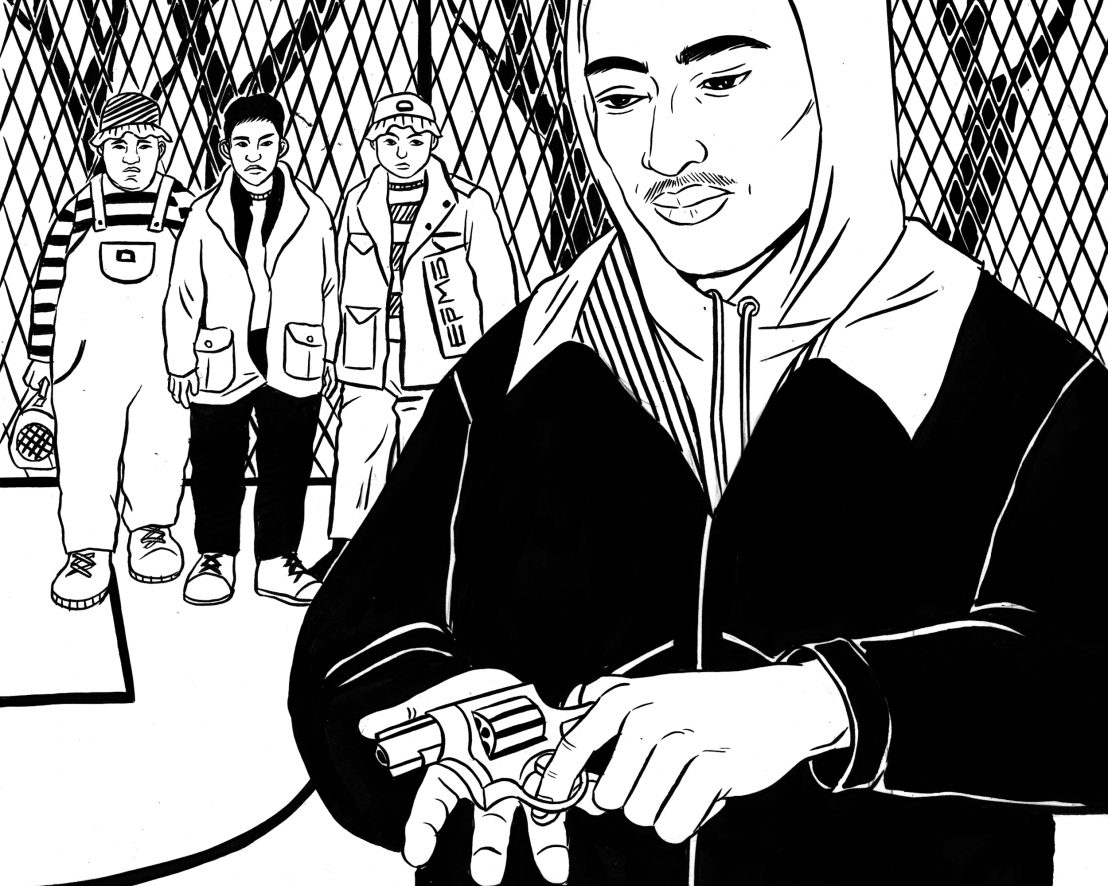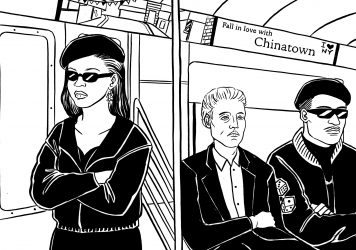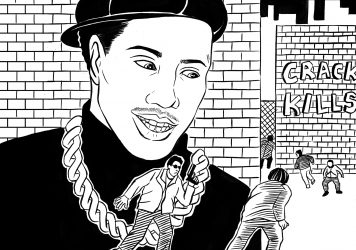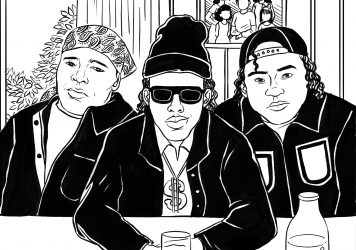
With its thrilling performances and damning anti-gun message, Ernest Dickerson’s portrait of America continues to touch a nerve.
This essay series looks at how five films released during rap’s golden era – King of New York, New Jack City, Juice, CB4 and Menace II Society – helped to shape American hip hop culture. We speak to filmmakers, rappers and historians to find out why these iconic works continue to endure.
Whether you consider 1992’s Juice a cautionary tale about gun violence or simply a reflection of everyday life for young African-Americans, its message still rings true more than a quarter of a century later. It centres on four black teenagers from Harlem, with their leader Q (Omar Epps) having dreams of becoming a hip hop DJ. However, Q’s ascent is derailed by tragic friend Bishop (Tupac Shakur) who turns into a monster the second he picks up a gun.
Director Ernest Dickerson shows an inner city where role models – aside from Samuel L Jackson’s moderately sympathetic youth club owner – are extinct, a place where gun violence presents opportunity rather than risk. And with guns 10 times more likely to kill black children than white children in America, according to a 2017 study, this sentiment now feels timeless.
Juice marked Dickerson’s directorial debut, having previously worked as a cinematographer for film school friend Spike Lee on Do the Right Thing and Jungle Fever. Written in 1982 and containing references to his own childhood (“When the kids run from the cops across the rooftops, that’s exactly what we used to do!” he says), Dickerson had to wait the best part of a decade to get Juice made. “I originally saw Juice as a Don Siegel film noir,” he reflects, “but I guess it evolved due to my horror of how prevalent guns were becoming. Things became totally different to when I was growing up, a time where beef was settled by boxing it out. Suddenly, in the early 1990s, you could accidentally step on someone’s sneakers and get shot. Me and Gerard [Brown, the co-screenwriter] were terrified by what was happening, and we wanted to put it on the big screen.”
This terror is driven by Tupac Shakur’s Bishop. The beating heart of the film, Shakur’s innocent eyes force you to empathise with the character no matter how twisted his actions (in one scene, he famously remarks: “Yes I’m crazy, but I don’t give a fuck!”) may be. Bishop comes from a broken home and as he observes his father comatose in front of a television set, it’s clear his heartbreak will only end in tragedy.
“We had a hard time casting Bishop,” recalls Dickerson. “But as soon as Tupac walked in we knew we were dealing with someone special. He found a way to tap into the pain of the character so you understand what forces him to make the decisions he makes. I remember doing some research where we interviewed young black men in the housing projects and asked them, ‘Where do you see yourselves in five to 10 years?’ Nearly all of them answered, ‘Dead!’ Bishop embodied that same mindset, and he was all about succumbing to peer pressure.”
According to West Coast rap legend Ras Kass, Bishop is someone, “You see every day in the hood,” something which made the film resonate with the hip hop community. He explains, “I had friends like Bishop who just couldn’t stop once they picked up a gun. They killed their friends but they weren’t bad people, it was just that the gun was the first time in their lives they were given any power. Bishop is a Greek tragedy. He was like Frankenstein’s monster – when you’re a young black male that’s been forgotten by society, all it takes is for someone to flip a switch and you can go crazy.”
Shakur was just 20 at the time of filming, yet Dickerson believes he already possessed a rawness and technique comparable to a young Brando. “On set Tupac would talk to anyone with an interesting story – it could be the guy taking out the rubbish or the woman serving up the coffee. He had this little notebook with him and would write it all down. I believe he did this so he could channel the pain and energy of these people into his acting and later on into his songwriting. I still dream about what we could have seen him do [in acting] if he had lived longer.”
Bishop is a character still referenced by contemporary rappers such as Vince Staples and A$AP Rocky. However, the continuing impact of Juice on hip hop culture isn’t purely down to the inspired casting of Shakur. Juice is a film designed for hip hop purists who aren’t quite ready to say goodbye to rap’s golden era; its opening shot shows a Def Jam vinyl spinning while its high energy soundtrack included the likes of Rakim, Naughty by Nature and Cypress Hill at the peak of their respective powers. Q, meanwhile, enters a DJ competition hosted by Queen Latifah at a grimy nightclub, a scene with a powder keg energy that was later copied by 8 Mile and its atmospheric freestyle battles.
According to Dylan Cave, a member of the curatorial team at the BFI National Archive, Juice marked a turning point for black cinema where filmmakers started to embrace hip hop culture as a lifestyle choice. He explains, “If you think of the early wave of hip hop movies like Breakin’, they are explicitly about hip hop being central to the narrative. In this second wave of movies, hip hop is shown as a way of life. From the fashion to the lifestyle choices the characters make, Juice is about hip hop culture as being lived rather than something that is done.” However, Dickerson admits that the film’s continued ties to hip hop culture have come as a surprise. “I’m told there’s a style of clothing and hair popular today that goes right back to Juice – it’s a trip!”
After Juice wrapped, Dickerson made the decision to go back into cinematography by working again with Spike Lee on his Malcolm X biopic. “It was about Malcolm, which me and Spike talked about for years, so I wasn’t gonna let anyone else shoot it!” he jokes. The now 66-year-old admits this decision caused confusion as Hollywood didn’t know whether to class him as a director or a cinematographer.
Dickerson arguably never made a better film than Juice, though his later directorial work on popular television series such as The Walking Dead and The Wire deserves a special mention. In fact, he was a pivotal creative force behind the latter show’s most tragic storylines – including the deaths of black teenagers Wallace and Bodie. You could say his work on The Wire was about bringing the cautionary themes of Juice to a new generation.
Above anything else, Dickerson sees Juice as a document of how America fails to provide role models for its most vulnerable citizens. In the film, Q is very much framed as the good guy, which makes the character’s visit to a back alley club to buy a gun a shocking development. What’s even more shocking is who he purchases the firearm from: a sweet-looking grandmother. “That lady who gives him the gun was actually my mother,” reveals Dickerson. “She had just retired from being a a librarian in Newark and dreamt about being in a movie so I helped her get an SAG card.”
That this is one possibility of what a gun dealer looks like in America is a big reason why the film still feels so relevant. As Dickerson explains, “I wanted to show that there’s no role models for these kids, that even granny is dealing guns and drugs. There were no role models for black kids in the inner cities in 1992 and there aren’t any in Donald Trump’s America either.”
Published 21 Mar 2018

By Thomas Hobbs
How Abel Ferrara’s brutal 1990 gangster flick captured the imagination of the hip hop community.

By Thomas Hobbs
The box office success of this 1991 drama forced America to view the crack epidemic from a different perspective.

By Thomas Hobbs
How a low-budget Chris Rock comedy exposed the absurdity of gangsta rap.